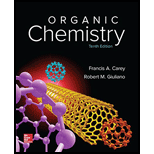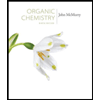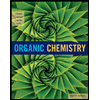
Organic Chemistry - Standalone book
10th Edition
ISBN: 9780073511214
Author: Francis A Carey Dr., Robert M. Giuliano
Publisher: McGraw-Hill Education
expand_more
expand_more
format_list_bulleted
Concept explainers
Textbook Question
Chapter 3, Problem 33P
Sight down the
Most stable conformation of
Two most stable conformations of
Two most stable conformations of
Expert Solution & Answer
Want to see the full answer?
Check out a sample textbook solution
Students have asked these similar questions
Draw a Newman projection of the most and the least stable conformation of the following compounds (sighting along the C2-C3 bond):
a) 2,3-dimethylbutane
b) 1,4-dichlorobutane
c) pentane
(assign strain energy to each conformation)
Please explain how you got your answers.
The most stable form of 1,2,3,4,5,6-cyclohexanehexol contains a six-membered ring in the chair conformation with all thesubstituents equatorial. Draw this most stable conformation of cyclohexanehexol.
Draw 2,4-dimethylhexane as a bond-line structure. Then, looking down the C3 – C4 bond, draw a Newman projection representation of the 1) lowest energy (most stable) and 2) highest energy (least stable) conformations.
Chapter 3 Solutions
Organic Chemistry - Standalone book
Ch. 3.1 - Identify the alkanes corresponding to each of the...Ch. 3.1 - Find the conformations in Figure 3.4 in which the...Ch. 3.2 - Sketch a potential energy diagram for rotation...Ch. 3.2 - Acetylcholine is a neurotransmitter in the central...Ch. 3.2 - Prob. 5PCh. 3.5 - The heats of combustion of ethylcyclopropane and...Ch. 3.8 - Prob. 7PCh. 3.10 - The following questions relate to a cyclohexane...Ch. 3.10 - Draw the most stable conformation of...Ch. 3.11 - Prob. 10P
Ch. 3.11 - Prob. 11PCh. 3.12 - Based on what you know about disubstituted...Ch. 3.12 - Write structural formulas for the most stable...Ch. 3.14 - Cubane (C4H8) is the common name of the polycyclic...Ch. 3.14 - Prob. 15PCh. 3.14 - Prob. 16PCh. 3.14 - Prob. 17PCh. 3.14 - Prob. 18PCh. 3.15 - Prob. 19PCh. 3 - Give the IUPAC names of each of the following: (a)...Ch. 3 - Draw Newman projections for the gauche and...Ch. 3 - Identify all atoms that are (a) anti and (b)...Ch. 3 - Prob. 23PCh. 3 - Prob. 24PCh. 3 - Prob. 25PCh. 3 - Prob. 26PCh. 3 - Prob. 27PCh. 3 - Prob. 28PCh. 3 - Oxidation of 4-tert-butylthiane proceeds according...Ch. 3 - The following are representations of two forms of...Ch. 3 - Draw (a) a Newman projection of the most stable...Ch. 3 - Write a structural formula for the most stable...Ch. 3 - Sight down the C-2-C-3 bond, and draw Newman...Ch. 3 - Prob. 34PCh. 3 - Sketch an approximate potential energy diagram for...Ch. 3 - Prob. 36PCh. 3 - Even though the methyl group occupies an...Ch. 3 - Which do you expect to be the more stable...Ch. 3 - Arrange the trimethylcyclohexane isomers shown in...Ch. 3 - Identify the more stable stereoisomer in each of...Ch. 3 - One stereoisomer of 1,1,3,5-tetramethylcyclohexane...Ch. 3 - One of the following two stereoisomers is...Ch. 3 - In each of the following groups of compounds,...Ch. 3 - The heats of combustion of the more and less...Ch. 3 - The measured dipole moment of ClCH2CH2Cl is 1.12D....Ch. 3 - Prob. 46PCh. 3 - Prob. 47PCh. 3 - Prob. 48DSPCh. 3 - Prob. 49DSPCh. 3 - Prob. 50DSPCh. 3 - Prob. 51DSPCh. 3 - Prob. 52DSPCh. 3 - Prob. 53DSP
Knowledge Booster
Learn more about
Need a deep-dive on the concept behind this application? Look no further. Learn more about this topic, chemistry and related others by exploring similar questions and additional content below.Similar questions
- Following is a chair conformation of cyclohexane with the carbon atoms numbered 1 through 6. (a) Draw hydrogen atoms that are above the plane of the ring on carbons 1 and 2 and below the plane of the ring on carbon 4. (b) Which of these hydrogens are equatorial? Which are axial? (c) Draw the alternative chair conformation. Which hydrogens are equatorial? Which are axial? Which are above the plane of the ring? Which are below it?arrow_forwardConsider 1-bromo-2-methylpropane and draw the following. (a) The staggered conformation(s) of lowest energy (b) The staggered conformation(s) of highest energyarrow_forwardName the following compound, identify each substituent as axial or equatorial, and tell whether the conformation shown is the more stable or less stable chair form (green=Cl):arrow_forward
- Draw the most stable conformation of(a) trans-1-tert-butyl-2-methylcyclohexane.arrow_forward4 Draw the Newman projection of each of the following conformationa along the C-C bond and the corresponding energy diagram for these conformations.arrow_forwardDraw (a) a Newman projection of the most stable conformation sighting down the C-3 C-4 bond and (b) a bond-line depiction of 2,2,5,5-tetramethylhexane.arrow_forward
- Draw the most stable conformation of (a) cis-1-tert-butyl-3-ethylcyclohexane.arrow_forwardFor the most stable conformation of trans-1,2-dimethylcyclohexane1. One methyl with occupy an axial position and the other an equatorial position.2. Both methyl groups will occupy axial position.3. Both methyl groups will occupy equatorial position.arrow_forwardDraw the most stable chair conformation of each of the following compounds. (a)cis-1,1,4 - trimethylcyclohexane (B) trans-1,1,3-trimethylcyclohexane (c) cis-1-fluro-4-ethylcyclohexane Please Give Step by Step Answer Otherwise i give DISLIKES !!arrow_forward
- Draw the Newman projection of the MOST stable and LEAST stable conformation. along in the C2-C3 bond. 3- Methyloctane 2,2-Dimethylbutane 2,3,4-Trimethylhexanearrow_forwardDraw the most stable conformations of cis-1,2-dimethylcyclohexane and trans-1,2-dimethylcyclohexane.arrow_forwardDraw the most stable conformation of trans-1-tert-butyl-3-methyl cyclohexane.arrow_forward
arrow_back_ios
SEE MORE QUESTIONS
arrow_forward_ios
Recommended textbooks for you

 Organic ChemistryChemistryISBN:9781305580350Author:William H. Brown, Brent L. Iverson, Eric Anslyn, Christopher S. FootePublisher:Cengage Learning
Organic ChemistryChemistryISBN:9781305580350Author:William H. Brown, Brent L. Iverson, Eric Anslyn, Christopher S. FootePublisher:Cengage Learning


Organic Chemistry
Chemistry
ISBN:9781305580350
Author:William H. Brown, Brent L. Iverson, Eric Anslyn, Christopher S. Foote
Publisher:Cengage Learning
Chapter 4 Alkanes and Cycloalkanes Lesson 2; Author: Linda Hanson;https://www.youtube.com/watch?v=AL_CM_Btef4;License: Standard YouTube License, CC-BY
Chapter 4 Alkanes and Cycloalkanes Lesson 1; Author: Linda Hanson;https://www.youtube.com/watch?v=PPIa6EHJMJw;License: Standard Youtube License